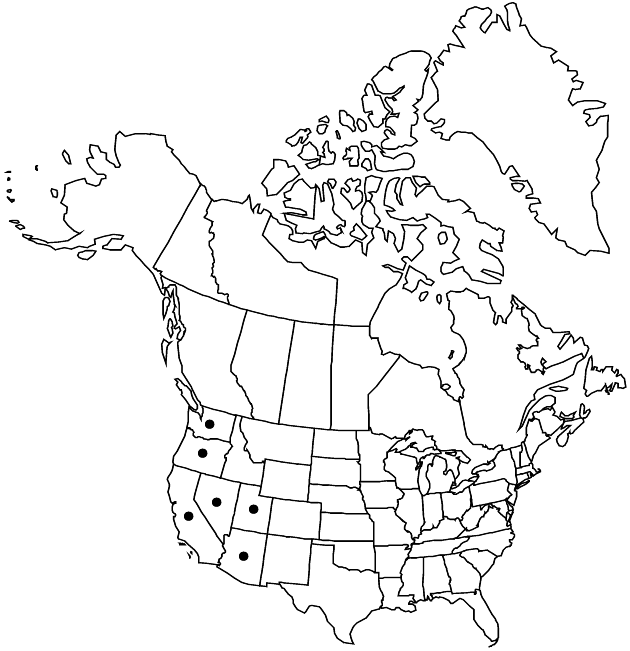Difference between revisions of "Agoseris retrorsa"
Pittonia 2: 178. 1891.
FNA>Volume Importer |
FNA>Volume Importer |
||
| Line 30: | Line 30: | ||
|elevation=400–2300 m | |elevation=400–2300 m | ||
|distribution=Ariz.;Calif.;Nev.;Oreg.;Utah;Wash.;Mexico (Baja California). | |distribution=Ariz.;Calif.;Nev.;Oreg.;Utah;Wash.;Mexico (Baja California). | ||
| − | |discussion=<p>Agoseris retrorsa appears to be most closely related to A. grandiflora. It superficially resembles A. parviflora and the two are sometimes confused. Agoseris retrorsa occurs primarily west of the Sierra Nevada; A. parviflora occurs primarily east of the same range. Cypsela characteristics will quickly separate them. Putative hybrids between A. retrorsa and A. grandiflora, A. hirsuta, and A. parviflora have been identified.</p> | + | |discussion=<p><i>Agoseris retrorsa</i> appears to be most closely related to <i>A. grandiflora</i>. It superficially resembles <i>A. parviflora</i> and the two are sometimes confused. <i>Agoseris retrorsa</i> occurs primarily west of the Sierra <i>Nevada</i>; <i>A. parviflora</i> occurs primarily east of the same range. Cypsela characteristics will quickly separate them. Putative hybrids between <i>A. retrorsa</i> and <i>A. grandiflora</i>, <i>A. hirsuta</i>, and <i>A. parviflora</i> have been identified.</p> |
|tables= | |tables= | ||
|references= | |references= | ||
| Line 54: | Line 54: | ||
|publication year=1891 | |publication year=1891 | ||
|special status= | |special status= | ||
| − | |source xml=https://jpend@bitbucket.org/aafc-mbb/fna-data-curation.git/src/ | + | |source xml=https://jpend@bitbucket.org/aafc-mbb/fna-data-curation.git/src/8f726806613d60c220dc4493de13607dd3150896/coarse_grained_fna_xml/V19-20-21/V19_505.xml |
|tribe=Asteraceae tribe Cichorieae | |tribe=Asteraceae tribe Cichorieae | ||
|genus=Agoseris | |genus=Agoseris | ||
Revision as of 15:12, 18 September 2019
Stems 0. Leaves erect to ascending; petioles often purplish; blades linear to linear-elliptic, (7–)10–30(–36) cm, margins usually lobed to pinnatifid, rarely toothed or entire, lobes (4–)7–9(–11) pairs, linear to lanceolate, mostly retrorse, sometimes spreading, lobules often present, faces sparsely villous to tomentose. Peduncles elongating after flowering, 15–65(–94) cm in fruit, ± glabrate, or apically villous to tomentose, eglandular. Involucres cylindric to obconic or campanulate, 4–6 cm in fruit. Phyllaries in 3–5 series, medially rosy purple or all green, lacking darker spots or midstripes, margins ciliate to tomentose, faces glabrous or villous, eglandular; outer erect to spreading, adaxially glabrous or tomentose; inner erect, often precociously elongating and much surpassing outer. Receptacles epaleate. Florets 10–100; corollas yellow, tubes 8–20 mm, ligules 6–15 × 1.5–2.5 mm; anthers 2–5 mm. Cypselae (15–)20–31 mm, bodies narrowly obconic, 5–7 mm, beaks (10–)15–25 mm, lengths mostly 3–4 times bodies; ribs strongly ridged, straight, often minutely cinereous-pannose; pappus bristles in 4–6 series, (11–)15–20 mm. 2n = 18.
Phenology: Flowering Apr–Aug.
Habitat: Mesic to dry habitats in scrub-lands, chaparral, steppe, and open oak or pine woodlands
Elevation: 400–2300 m
Distribution

Ariz., Calif., Nev., Oreg., Utah, Wash., Mexico (Baja California).
Discussion
Agoseris retrorsa appears to be most closely related to A. grandiflora. It superficially resembles A. parviflora and the two are sometimes confused. Agoseris retrorsa occurs primarily west of the Sierra Nevada; A. parviflora occurs primarily east of the same range. Cypsela characteristics will quickly separate them. Putative hybrids between A. retrorsa and A. grandiflora, A. hirsuta, and A. parviflora have been identified.
Selected References
None.